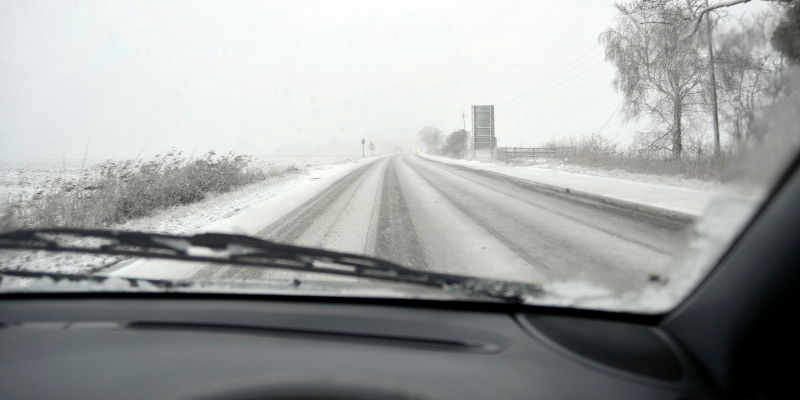
Preparing For Winter Driving
Heavy rain and snow can cause mass disruption on our roads, especially during rush hours. So are you prepared for winter driving and dealing with the potentially poor weather conditions? Well, we've put together some useful top tips to ensure you have a safe journey whilst driving this winter. From equipping your vehicle with the right gear to adopting the proper driving techniques, we'll cover it all.
Plenty of Space
Maintaining a safe following distance is a important rule of safe driving that cannot be emphasised enough. This simple yet crucial practice can prevent road accidents and provide you with more time required to react to unexpected situations. Leaving plenty of space between your car and the vehicle in front is particularly important during adverse weather conditions with rain, snow, or fog. Reduced visibility and slippery roads increase stopping distances so allow more space for this.
In ideal driving conditions, the recommended following distance is at least three seconds. However, in adverse conditions, it's advisable to double or even triple this following distance to ensure ample reaction time. By adhering to this simple guideline, you not only reduce the risk of rear-end collisions but also contribute to smoother traffic flow.
Slow down!
Slowing down when weather conditions take a turn for the worse is another fundamental principle of safe driving. Whether you encounter heavy rain, snow, ice, fog, or other adverse conditions, reducing your speed can be the key to avoiding accidents and ensuring everyone's safety on the road. When roads become slick or visibility decreases, your vehicle's ability to grip the road and your reaction time are compromised. This means that it takes longer to stop, and sudden manoeuvres become riskier. By slowing down, you provide yourself with crucial extra seconds to respond to unexpected situations and come to a controlled stop if necessary.
In adverse weather conditions, even the road speed limits can be too fast. It is essential to exercise heightened caution, particularly when driving around bends or overtaking other vehicles. Quick acceleration or harsh braking unnecessarily is dangerous and should be avoided. It’s crucial to bear in mind that the speed limit is not a target, it's the legal maximum speed for that exact road, so take your time. Driving at a reduced speed also minimises the risk of aquaplaning on wet roads or losing control on icy surfaces.

Plan your journey
Before setting off, you should plan your journey as this could save you time, money, and unnecessary hassles. Adverse conditions may require adjustments to your departure time or even a change in your travel plans so allow extra time for this. Also, take extra care if your journey requires you to drive down backstreets or country lanes as these areas are more likely to be in poor condition. In case of an emergency, ensure your mobile phone is charged before starting your journey and have your breakdown recovery details with you.
Similarly, knowing your route is essential. Utilise maps, GPS devices, or navigation apps to get your your destination. Consider alternate routes in case of unexpected road closures, construction, or traffic jams. Familiarise yourself with the locations of rest areas and fuel stations, especially for longer trips.
Fuel up
Keep an eye on your vehicle's fuel level to ensure you have enough. Poor weather conditions can cause traffic and therefore increase your journey time. Plus, adverse conditions can result in a decrease in fuel economy. Similarly, if you have a hybrid or electric car, you should ensure it is sufficiently charged before starting your winter journeys. It might also be worth downloading the Zap Map app to help locate and navigate to over 30,000 public charging points for electric vehicles across the UK.
Take your time
Often accidents are caused by drivers rushing around and not thinking properly. Even if your car is considered better at handling winter weather conditions than others, you should still be careful. Adverse weather conditions introduce a host of challenges that demand cautious and patient driving practices. Therefore, take your time and consider other road users too. Smooth and gentle movements are key. Avoid sudden acceleration, harsh braking, and sharp turns. Gradual inputs on the throttle, brakes, and steering wheel help maintain vehicle stability and reduce the risk of skidding or loss of control.
Remain Vigilant
Heavy snow or rain could impair visibility whilst driving and cause slippery surfaces. Remain extra vigilant for pedestrians, animals or other objects on the road as it could be increasingly difficult to see them. If you’re having problems with your eyesight, it’s important to get your eyes tested at an optician.
Clear view
Maintaining a clear windscreen is vital to guarantee an unobstructed view of the road, especially in severe snow conditions. Your vehicle's windscreen provides a crucial line of sight, and any hindrance can impede your capacity to respond to potential hazards effectively. Ensure that your wiper blades are in optimal condition, and if they fail to clear the glass thoroughly, consider replacing them.
Before commencing your journey, you should check that your car lights are working properly, and the windscreen is clear. If your windows end up icy or fogged up, putting the car heater on will help to resolve this. Equally important is keeping your windscreen free from cracks or chips. Even minor damage can weaken the structural integrity of the glass and impair your vision. Address any such issues promptly, as they may worsen over time and result in costly replacements.

Check tyres
Regularly checking your tyres is a vital aspect of vehicle maintenance that significantly contributes to your safety on the road. Your tyres are the only points of contact between your vehicle and the road surface, making them a critical factor in handling, braking, and overall stability. Tyres work best when they're inflated to the correct pressure and it can improve your fuel mileage by up to 3.3%. Therefore you should regularly check your car tyres for damage or weak spots and check the tyres' pressure. If you're unaware of the correct tyre pressure for your vehicle, then refer to your owner's manual. You could also consider investing in some winter tyres.
Sensible Thinking
In the face of extreme weather conditions, the golden rule to remember is that you should only venture out on the road if it's absolutely necessary. Extreme weather encompasses situations like blizzards, heavy storms, flooding, or any other conditions that pose severe risks to drivers. If you think it's too dangerous to drive, then cancel or amend your plans, if possible. Staying home or seeking shelter until the worst of the weather passes is often the safest course of action.
Winter Essentials
In poor weather conditions, it's a good idea to always have winter essentials in your vehicle. This may include winter boots, a torch, a scraper and warm clothing etc. This could come in handy if your vehicle ends up stuck in deep snow or with a flat battery. An ice scraper is good for clearing your windscreen and windows, ensuring visibility while driving.
There you have it, our top tips for driving this winter. In conclusion, preparing for winter driving is not just a matter of convenience; it's a commitment to safety. As the icy winds and snowflakes descend, taking proactive steps like equipping your vehicle, adjusting your driving habits, and staying informed about weather conditions can make all the difference. If you liked reading this blog, click here for more of our latest news and reviews. Also, for more useful tips and stock alerts, follow us on Facebook or Twitter where we promote our latest in stock lease deals.
Latest Posts

Discover Your Perfect Halloween Car Match
Find Your Halloween Ride: Which Spooky...

Jeep Avenger Review 2024
Meet the Jeep Avenger, the brand’s...

A Comprehensive Kia Stonic Review
See for yourself if this could...

Cheap Vans to Lease 2024
Let's explore some of the cheapest...

Exploring Excellence: Isuzu D-Max Review 2024
In this Isuzu D-Max review, we'll...


































